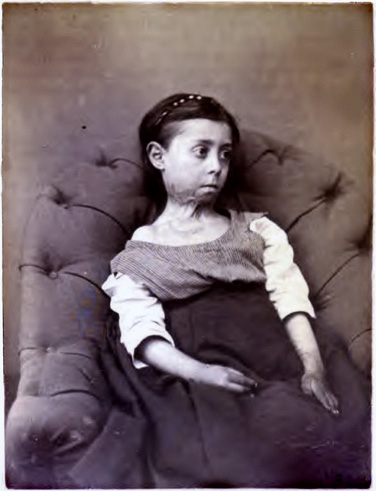
Journal : Revue photographique des hôpitaux de Paris ; vol. 2.
Paris : Adrien Delahaye, 1870.
Description : 225-229 p., [2 l. pl.] ; ill.: 2 photo., 1 fig. ; 24.5 cm.
Photographs : 2 mounted albumens of a 7 year-old female, before and after plastic surgery.
Subject : Cicatrices from burns — Plastic surgery (of); Surgical instrumentation.
Notes :
En effet, ajouterons-nous encore, tandis que pour les sujets qui appartiennent à la classe aisée, il est possible d'avoir recours à des appareils de précision, spécialement fabriqués pour chaque cas, pour les enfants que l'on soigne dans les hôpitaux, l'administration, avec sa parcimonie habituelle, ne se déciderait jamais à fournir les appareils indispensables. — p. 227.
Again we submit the reality that whereas for subjects which pertain to the leisure class it is possible to have recourse to precision instruments especially manufactured for each case, contrariwise, the administration with its usual parsimony would never deign to provide the necessary instruments for children who are attended in the hospitals.

The photographs illustrating this paper are dark and powerful portraits of a child whose character expresses the private depths of a suffering that left her face and jawline misshapened from fire. She was operated on by the Portuguese born Joachim Giraldès who, in order to compress the edges of the wound, used a forceps of his own invention which he had fabricated by the instrument maker, Georges Guillaume Amatus Luer (1802-) of Paris. Giraldès was a brilliant surgeon and anatomist who was blinded in one eye during an autopsy when a chip from a calcified larynx flew off and caused the destruction. This occurred in 1854, but after that date he gradually lost sight in his other eye and eventually had to give up his surgical practice to devote his time to bibliographical work. The drawing of Luer's instrument was first published by Giraldès in his 1869 monograph (op. cit.) on childhood diseases, a work that was transcribed from lectures by Bourneville and E. Bourgeois. Throughout his life Bourneville was a tireless advocate for the health of indigent children, was prominent in the pediatric wards of Bicêtre where he held the title of Médecin des services d'alienés from 1879 to 1905, and founded the first school for disabled and mentally defective children. The harsh words quoted above are a clear representation of his idealism.
1 Giraldès (1869), [edited by Bourneville & Bourgeois] Leçons cliniques sur les maladies
chirurgicales des enfants. Paris: Adrien Delahaye; page 501.
